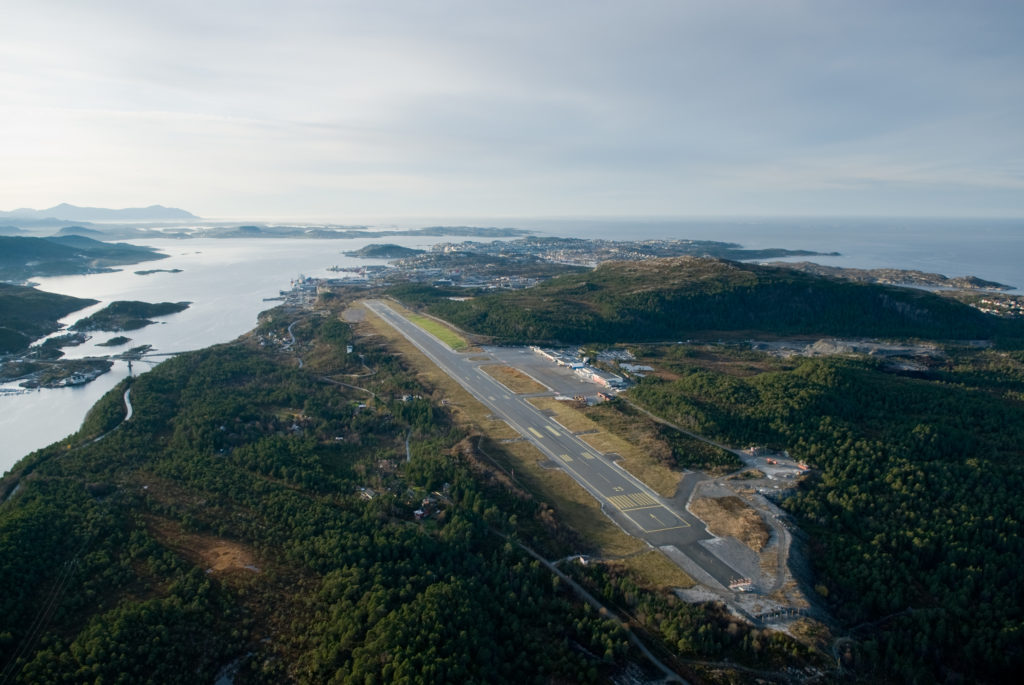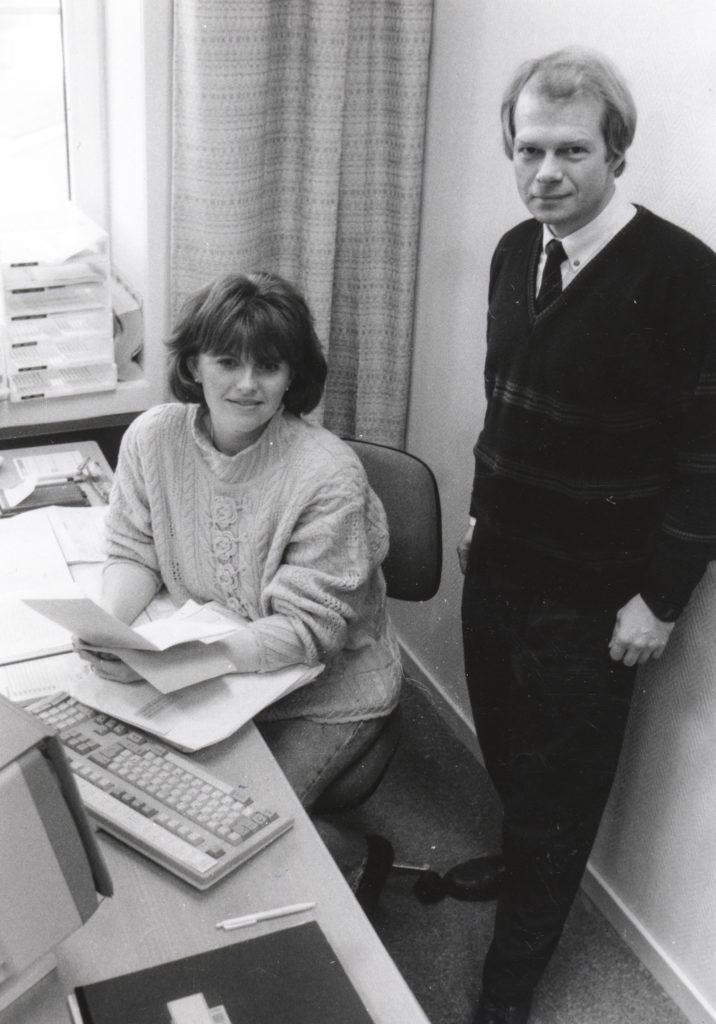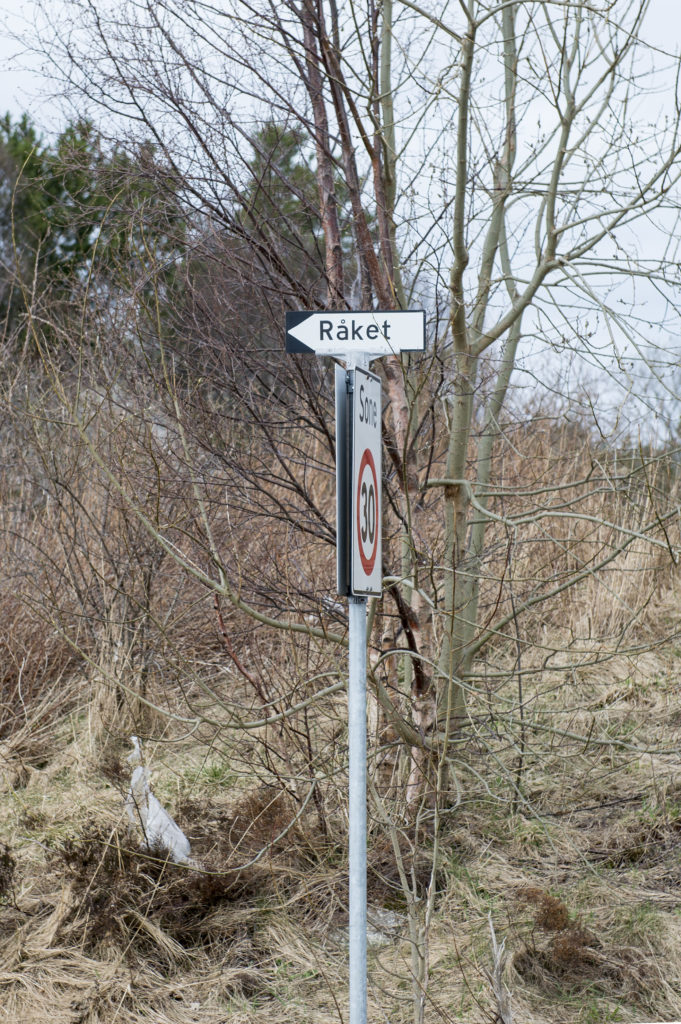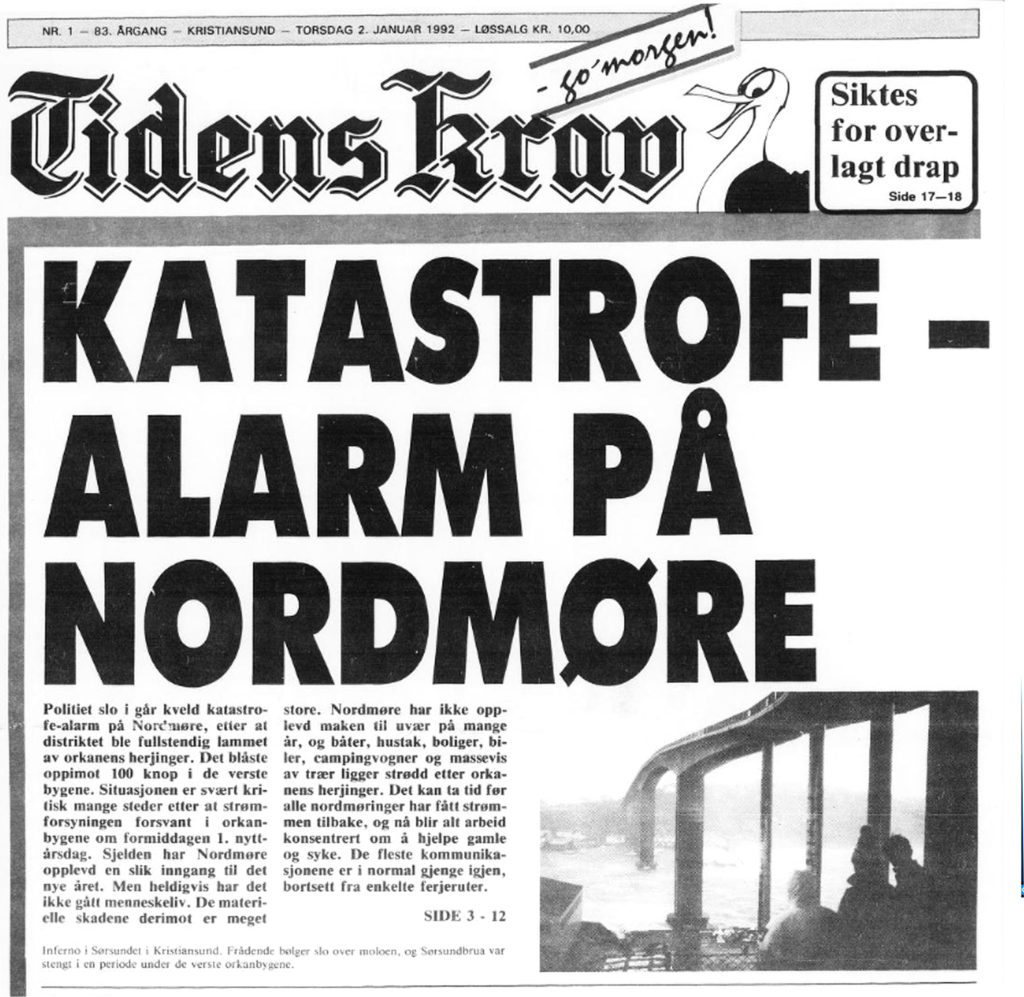Building an operational presence

Anton Monge, chief administrative officer for Kristiansund town council, described the position in the following way during his speech at the official opening:
We are now taking part in the birth of the Draugen project, and the pregnancy has lasted for 20 years. Draugen has 20 years ahead of it, and I hope Shell will become even older in Kristiansund.
Read more about this topic in the article on Kristiansund becoming an oil town.
 etablering av kontor i kristiansund, engelsk,
etablering av kontor i kristiansund, engelsk,The new office was not initially intended to handle operations, but to function as an interface between Shell and local industry in the region around the town. It provided a temporary presence for the company until the permanent operations organisation moved three years later into the new building being constructed at Råket.
Located in Verkstedveien, the office was close to Vestbase – the main supply facility for exploration in the Halten Bank area of the Norwegian Sea. Norsk Hydro was based next door and the local airport at Kvernberget was only a few kilometres away.
The Storting (parliament) voted in December 1988 that Draugen would be operated from Kristiansund, which would also host the supply base for this field, Heidrun and Halten Bank exploration.[REMOVE]Fotnote: Ministry of Petroleum and Energy. (1988). Proposition no 1, supplement no 2 (1988-1989) for the 1989 budget period. Utbygging av Draugenfeltet og lokalisering av drifts- og basefunksjoner for feltene Draugen og Heidrun.
It also resolved, incidentally, that the operations office for Conoco-operated Heidrun would be located at Stjørdal outside Trondheim.
After 18 years of toil, the town would now be getting both an operations office and the associated jobs. It was high time – with the local economy characterised by the worst unemployment in Norway, a crisis mood prevailed there.
Read more in the article about Kristiansund in crisis.
Identify and qualify
 etablering av kontor i kristiansund, engelsk,
etablering av kontor i kristiansund, engelsk,The Shell offices were not large, but would meet the company’s requirements until the Råket building was ready. It only had two staff initially, including secretary Marit Tomelthy. Her boss was industry coordinator Roy Ødegård, whose most important job was to provide information to and forge contacts with local industry, government, research institutes and media.[REMOVE]Fotnote: Shell Internt, 7 December 1989, “Draugen med postadresse Kristiansund”.
Ødegård had experience from Møre og Romsdal county council as its long-serving oil coordinator, and was recruited by Shell in 1987 to set up an industry office for Draugen in Trondheim. That was because the company had hesitated to commit to Kristiansund until the Storting took its decision. It therefore opted for a location in the regional centre of mid-Norway.[REMOVE]Fotnote: Interview with Roy Ødegård by Trude Meland, Råket, Kristiansund, 25 August 2016.
To achieve efficient and profitable operation of Draugen, Shell would depend on a well-developed infrastructure and close collaboration with companies able to deliver goods and services at competitive prices.
Prequalifying mid-Norwegian industry was therefore among the highest priorities, and an aggressive identification and evaluation of available suppliers was pursued from the start.
Ødegård visited companies which might be relevant for operational and maintenance services, and a number of presentations and seminars were given on the Draugen project.
The first series of these for mid-Norwegian industry was held separately in the three counties making up this region – Møre og Romsdal, Sør-Trøndelag and Nord-Trøndelag. Together with the Confederation of Norwegian Enterprise (NHO) and the Norwegian Confederation of Trade Unions (LO), the county councils were in the process of identifying relevant companies.
Seminars took place in six locations during May-June 1990 after 831 companies had been assessed. Of these, 411 were invited to attend and 185 actually turned up.[REMOVE]Fotnote: Shell Internt, 3 June 1990. “Draugen og Midt-Norge”. After the sessions, 117 enterprises were still interested in collaboration. The next step was qualifying and involving them in construction and future operating assignments.[REMOVE]Fotnote: Norsk Oljerevy, issue 2, 1991. “Shell evaluerer midt-norske bedrifter for Draugen”.
Seventy companies were invited to the Møre og Romsdal seminar, with 48 attending. Twenty-one were invited from Nordmøre itself and 16 turned up.
The level of interest in Kristiansund and its hinterland was good, and a number of companies also opted to visit the new office in Verkstedveien.
In many cases, the most challenging job was to explain to interested firms that they lacked the right expertise. A Shell team opted to visit many of them to assess their qualifications. Although this was resource-intensive, the companies were pleased.
Been here before
Shell had been a familiar name in Kristiansund for many years before oil production became relevant on the Halten Bank – indeed, long before anyone conceived of oil on the Norwegian continental shelf (NCS) or offshore operations anywhere in the world.
The town got its first agency for Norsk-Engelsk Mineralolie Aktieselskab (later Norske Shell) in 1921, when a tank, quay and filling shed were built at Dale in the Nordlandet district. This facility was expanded in 1923 with a marine diesel oil tank and bigger quay, and a “petrol station” was opened in the town that year with a tank at Vaagekaien in Kirkelandet.[REMOVE]Fotnote: Hegerberg, H (2004). Et stille diplomati: Oljebyen Kristiansund 1970-2005. Kristiansund: Kristiansund local authority: 204.
 etablering av kontor i kristiansund, engelsk,
etablering av kontor i kristiansund, engelsk,When Shell moved into the new office building at Råket in 1992, five staff from the nearby Dale depot turned up to welcome their new colleagues.
Råket
 etablering av kontor i kristiansund, skilt, råket, engelsk,
etablering av kontor i kristiansund, skilt, råket, engelsk,The office in Verkstedveien was a temporary solution. When it became clear that Shell and Draugen would be going to Kristiansund, the council wished them both heartily welcome. It made available the best site at its disposal at Råket in Nordland, which occupied a beautiful position along the highway into town.
A design competition was announced, and four architect practices in Møre og Romsdal submitted ideas for the building, with its 4 000 square metres of space.[REMOVE]Fotnote: Shell Internt, 9 November 1990, “Draugenorganisasjonen på full fart til Kristiansund”. Kosbergs Arkitektkontor A/S in Molde won the competition. It had proposed a futuristic style which sought to meet the many considerations which had to be taken into account.
Not only was an agreeable office building to be constructed, with opportunities for expansion, but nature and the environment on the site were to be preserved. The internal layout had to provide good opportunities for informal contact between employees, exchange of professional experience and strengthening of social cohesion.[REMOVE]Fotnote: Shell Internt, 7 December 1990, “Shell-bygget i Kristiansund”. Kristiansund mayor Harald Stokke cut the first sod for the construction project in March 1991.
Historic hurricane
 etablering av kontor i kristiansund, avis, faksimile,
etablering av kontor i kristiansund, avis, faksimile,Kristiansund was set to enter a new era in 1992, when the town finally became the oil centre for mid-Norway with the opening of Shell’s new operations office and jobs flocking in. But the year opened in the worst possible way, with the most powerful hurricane registered by the Norwegian Meteorological Institute since records began in 1867.[REMOVE]Fotnote: Norwegian Meteorological Institute, 28 December 2016, “25 år siden den historiske nyttårsorkanen”. Downloaded from https://www.met.no/nyhetsarkiv/25-ar-siden-den-historiske-nyttarsorkanen on 9 January 2018. The hurricane has no name, because the meteorological institute did not begin naming such events until 1995.
The storm which hit the west coast on 1 January 1992 caused one death and was the most expensive in Norwegian history measured by material losses. Some 50-60 000 buildings were destroyed, with extensive damage also caused to infrastructure, historical monuments, fish farms and not least forests. Power cuts caused big operating losses for industry, and provisional energy solutions were being used in certain parts of the country for a long time.[REMOVE]Fotnote: Directorate for Civil Protection and Emergency Planning (2012). Nasjonalt risikobilde 2012: 20. Downloaded from https://www.dsb.no/globalassets/dokumenter/rapporter/nrb_2012.pdf on 9 January 2018.
This hurricane opened not only the year Shell was to establish itself seriously in Nordmøre, but also the 250th anniversary of Kristiansund’s acquisition of municipal status.
The town suffered a five-day power cut, and the loss of telephone connections contributed to chaotic conditions. It was declared a disaster area and a full crisis response was mobilised.
Shell’s offices were still in Verkstedveien when the storm struck, ripping off much of the roof and more or less crippling communications. Despite warnings against moving about in the open, some people got to the building and covered most of it with plastic. But water still rose inside, and conditions worsened on 2 January.
Documents and office furnishings had to be moved as quickly as possible – first to temporary quarters at Vestbase and then to an abandoned dairy in the town centre.
The office was functioning again the day after this move, and personnel were able to return to the Verkstedveien building in March.[REMOVE]Fotnote: Shell Internt, January/February, 1992, “250-års jubileum innledet med orkan”.
Meanwhile, the topping-out ceremony for the new offices at Råket could take place on 5 March when completion of the roof could be appropriately celebrated.[REMOVE]Fotnote: Shell Internt, 3 April 1992)], “Shellbygget under tak”.
A steady growth in staff over the year meant Shell had to lease additional space in Verkstedveien with room for 100 people in June – two months before the new offices were to open.
The company needed more capacity at this stage than the Råket building would provide. This related particularly to offshore personnel who needed offices before moving to the platform, and to consultants and people on short-term contracts.
When Draugen came on stream in 1993, however, the whole workforce in Kristiansund would be able to fit into the new offices.
All eyes on Shell
Local politicians were pleased at Shell’s arrival, aware that this would bring in a number of highly qualified and experienced people who would be a resource for both town and region. But this development was not without its controversial aspects. Jan Erik Larsen, editor of local newspaper Tidens Krav, among the sceptical voices.
 etablering av kontor i kristiansund, avis, faksimile,
etablering av kontor i kristiansund, avis, faksimile,In an open letter to his readers, he warned against privileged groups moving in from outside and taking over control of most things – and the most important.
He feared that Shell’s culture would live its own life in the town. Although he was convinced that the company’s management would avoid anything which smacked of privilege, it would not take much of this before locals reacted.
Larsen highlighted existing mutterings about special treatment in the award of day care nursery places and housebuilding sites, and was sure that pay levels would be the subject of discussion.
He concluded that Kristiansund was justified in seeking to attract industry, but that this had to be done without “unreserved grovelling” or fawning on the giant companies.
Openness was essential, Larsen said. Kristiansunders were admittedly fairly open towards and tolerance of newcomers, but narrow-mindedness also flourished there as elsewhere.[REMOVE]Fotnote: Tidens Krav, 21 March 1992, “Den nye stammen”.
Shell had said it would help to finance a new day care nursery at Løkkemyra, close to the Verkstedveien offices. However, nursery places available to its employees would not be confined to this Fosna facility, but spread around where they lived.
The company had signalled that it needed 42 places. That created a financial basis for the council not only to build but also to bring forward the Fosna project for a 1992 opening.
This assumed that the council would face no net cost in establishing or running the new nursery, but the deal depended on the sale of 40-45 places to Shell.
A month after the construction decision was taken, however, the chief administrative officer revealed that the whole basis for the project had been changed.
During the process, Shell had reduced its requirement to a maximum of 30 places, including 15 reserved for infants under the age of three. At 25-30 places, the basis for building the nursery at no cost had gone.[REMOVE]Fotnote: Tidens Krav, 3 June 1992, “Subsidierer Shell med 40.000”. The Fosna facility nevertheless went ahead, but at the cost of much resentment among local residents and politicians.
Agreement was also reached that Shell would take about 50 per cent of the places Kristiansund council could offer for children up to the age of three.
The town’s own residents would thereby have problems getting their own under-fours in.[REMOVE]Fotnote: Sveinung Solberg, “Barnehager”, Tidens Krav, 7 July 1992. A number of politicians had great qualms that one company in the town could determine so much.
Allocation of the town’s “best” housing development land was the other big issue, with the council’s executive board reserving the necessary sites for key personnel in new industries.
Mayor Stokke said that providing land for new arrivals was a key concern for the town. It was important that the office head lived there because his high income would boost tax revenues. Shell had wanted a site to build a distinguished residence for the leader of its Draugen organisation, and the executive board reserved five plots in an attractive area of detached homes. Two were allocated for the Draugen head.[REMOVE]Fotnote: Tidens Krav, 24 March 1992, “SV spør om Shell-tomt”.
All eyes in the local community were on Shell. The company was fully aware of this, and encouraged its employees to play an active part in community life. It was important that they did more than cultivate a distinctive “Shell” culture.
In connection with the move to and start up of the operations office, the company established a dedicated magazine under the name EPO Express. Operations head Terje Olsen wrote in a leading article for the first issue that Shell aimed to be a positive factor for the community everywhere it worked – including Kristiansund.
Its own recreation club would be integrated as far as possible in the town’s existing sports and activities, at the same time as a social network was created within the company.[REMOVE]Fotnote: Epo Express, May 1992.
Perhaps a little surprisingly, there was otherwise little discussion around Shell’s arrival. When it moved into the Råket building in August 1992, and not least when Draugen came on stream in October 1993, local people were proud residents in the new oil town.
Read more about the construction of the Råket building and the big move project.
Photo: Building Shell’s office at Råket
Laying the ghostsTopsides assembly and contract problems